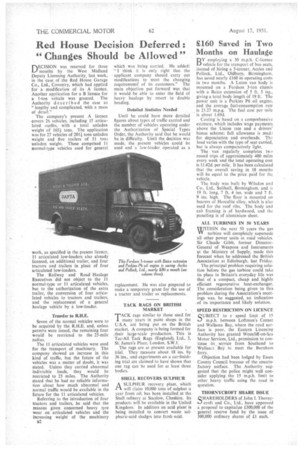Red House Decision Deferred " Changes Should be Allowed "
Page 36

If you've noticed an error in this article please click here to report it so we can fix it.
DECISIGN was reserved for three months by the West Midland Deputy Licensing Authority, last week, in the ease of the Red House Garage Co., Ltd., Coventry, which had applied for a modification of its A licence. Another application for a B licence for a 1-ton vehicle was granted. The Authority d e sc ri bed the case as " lengthy and complicated, with a mass of detail."
The company's present A licence covers 26 vehicles, including 15 articulated outfits, with a total unladen weight of 165-i tons. The application was for 27 vehicles of 2011 tons unladen weight and five trailers of 51 tons unladen weight. These comprised 11 normal-type vehicles used for general work, as specified in the present licence. 11 articulated low-loaders also already licensed, an additional trailer, and four tractors and trailers in place of four articulated low-loaders.
The Railway and Road Haulage Executives did not object to the 11 normal-type or II articulated vehicles, but to the authorization of the extra trailer, the conversion of four articulated vehicles to tractors and trailers, and the replacement of a general haulage vehicle by a low-loader.
Transfer to R.H.E.
Seven of the normal vehicles were to be acquired by the R.H.E. and, unless permits were issued, the remaining four would be restricted to the 25-mile radius.
The 11 articulated vehicles were used
for the transport of machinery. The company showed an increase in this kind of traffic, but the future of the vehicles was a matter of doubt, it was stated. Unless they carried abnormal Indivisible. loads, they would be restricted to 25 miles. The Authority stated that he had no reliable informathm about how much abnormal and normal traffic would be available in the future for the 11 articulated vehicles.
Referring to the introduction of four tractors and trailers, he said that the reasons given concerned heavy tyre wear on articulated vehicles and the increasing weight of the machinery 82 which was being carried. He added: " I think it is only right that the applicant company should carry out modifications to meet the changing requirements of its customers." The main objection put forward was that it would be able to enter the 'field of heavy haulage by resort to double heading.
Debited Statistics Needed Until he could have more detailed figures about types of traffic carried and the number of vehicles operating under the Authorization of Special Types Order, the Authority said that he would be in difficulty. Until the decision was made, the present vehicles could be used and a low-loader operated as a replacement. He was also prepared to make a temporary grant for the use of a tractor and trailer as replacements.
TACK RAGS ON BRITISH MARKET TACK rags similar to those used for i many years in paint shops in the U.S.A. are being put on the British market. A company is being formed for .their large-scale production. This is Tac-All Tack Rags (England), Ltd., 5, St: James's Place, London, S.W.1.
The rags are at present available for trial. They measure about 18 ins. by 36 ins., and experiments on a car-finishing trial are claimed to have shown that one rag can be used for at least three bodies.
SHELL RECOVERS SULPHUR
ASULPHUR recovery plant. Vvhich will claim 10,000 tons 'of sulphur a year from oil, has been installed at the Shell refinery at Staulow, Cheshire. Itsproducts will be available in the United Kingdom. In addition an acid plant is being installed to convert waste sulphuric-acid sludges into fresh acid.




















































































